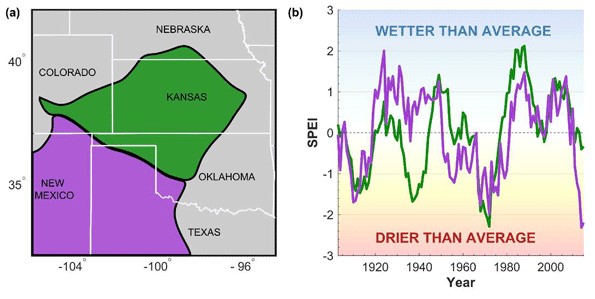By Xiaomao Lin
This article is part 2 of a 4-part series focusing on agriculture, climate, and change. The first installment was featured in eUpdate Issue 710 on September 14, 2018.
Drought can decimate agricultural production in the U.S. Great Plains and throughout the world. We all recognize drought. The dull green vegetation; the pallor of dust-filled skies; the dry scratchy throat and persistent cough. Agriculture? Drought can potentially stop agriculture in its tracks. In the High Plains of western Kansas, agriculture affects a third of the regional economy. In Sub-Saharan Africa, drought affects the core food supply, leading to rural exodus and civil unrest. In northwest India, drought amplifies the frequency of heat-related deaths. In Cape Town, South Africa, a two-year drought threatens the water supply for the four million residents. Drought touches our lives and communities in a myriad of ways.
The Palmer Drought Severity Index (PDSI), published in 1965, considered drought cycles of the 1930’s and 1950’s. The PSDI uses monthly precipitation data and atmospheric demand for water, to estimate any changes in the soil water supply relative to ‘normal’ conditions. The concept of ‘normal’, or long-term average weather is central to many drought indices used today. In the U.S., a Drought Monitor (
http://droughtmonitor.unl.edu/) displays its index using fire colors—yellow, orange, red , in which drought metrics provide early warning of impending disasters in the U.S. On the global scale, the Global Drought Information System (NIDIS) (
https://www.drought.gov/gdm/current-conditions) provides online global drought information (Figure 1) as well as vegetation health index.
Figure 1. Current Global Drought Monitor. Drought intensity is coded by red colors represent drought and blue colors represent wetting conditions.
The American Meteorological Society hosted four sessions on drought and food security during its 2018 meetings. One of several global-scale drought monitoring programs utilizes satellite imagery to calculate and map the energy balance for land surfaces. This accounting scheme uses physics to sum inputs and outputs in terms of radiation, evaporation, and warming/cooling of air and land. The thermal band from satellites, representing the surface temperature, conveys critical information of surface water availability. Warmer sectors indicate dry surfaces while the wet regions display cooler temperatures.
Globally, agencies use these techniques to detect and report early-stage and ongoing drought. These early warnings and updates inform emergency drought responses. Earth scientists recognize drought as an integral component of the hydrological cycle. The question remains: Has a changing climate affected the frequency, duration, or extent of drought?
Zambreski and Lin (2017) reported a new technique to evaluate long-term climate trends. This method uses Empirical Orthogonal Functions (EOF, a type of principal component analysis) to characterize monthly drought metrics of the U.S. Great Plains over the 20th century (1903 to 2015). The EOF were correlated with each of the localized time series of drought metrics to identify regions with similar historic patterns of wetting and drying cycles (Figure 2). Analyses such as this provide benchmarks against which climate change trends can be usefully compared.

Figure 2. (a) Two sub-regions in the Great Plains for spring drought variability and (b) their corresponding drought time series from 1903 to 2015. Positive values in the time series represent wetter than average conditions, and negative values represent drier than average conditions. There are notable differences in the drought conditions of these adjacent sub-regions during the 1930s (Dust Bowl era) and the period 2010-2015. The drought index is the Standardized Precipitation Evapotranspiration Index (SPEI) on a 3-month time scale.
As earth scientists, we recognize the tools at our disposal to identify and quantify drought. Careful application of these tools can help farmers and water managers anticipate and prepare for the next drought.